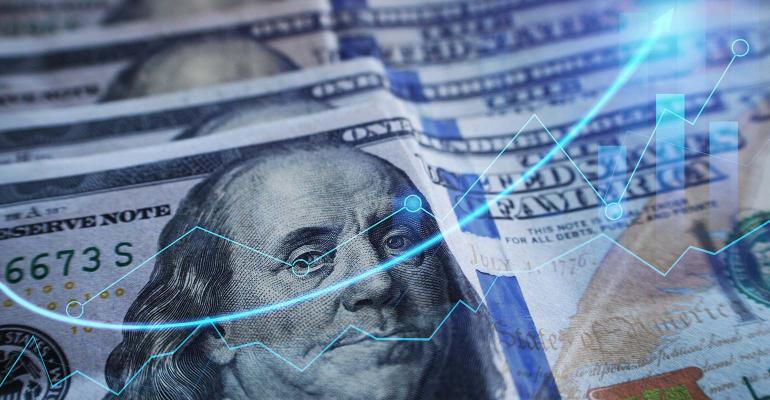(Bloomberg) -- Investors, shaken by the ongoing turmoil in the banking industry and seeking higher yields, are racing into money market funds.
About $350 billion flowed into money funds in the four weeks ending April 5, according to the Investment Company Institute. That pushed assets to a record $5.25 trillion, topping the $4.8 trillion pandemic peak.
Read more: Investors Seen Pouring $1.5 Trillion More Into the Safest Money Funds, Barclays Says
There are plenty of reasons to like money market funds right now, but they also come with risks, experts say. Here’s what you should consider when deciding whether to invest in one.
What Are Money Market Funds?
Money funds are a kind of mutual fund. They’re generally used to park cash that’s waiting to be invested or needed in the near future.
They hold short-term, liquid instruments, including cash, certificates of deposit and US Treasury bills, and follow federal guidelines around quality, maturity, liquidity and diversification. They’re required be at least 10% invested in daily liquid assets and 30% in weekly liquid assets; the Securities & Exchange Commission is proposing to raise that to 25% and 50%.
Read more: Why US Banks Are Hemorrhaging Deposits to Money Funds
The funds have historically maintained a $1-a-share value, with interest paid in dividends. There’s no guarantee investors won’t lose money — the funds aren’t insured by the FDIC — but they would quickly lose appeal if “breaking the buck,” or having the fund’s net asset value sink below $1, became common.
Fees among big retail fund providers range from 0.09% at Vanguard to 0.34% at Schwab and 0.42% at Fidelity. You can buy the funds on brokerage or mutual fund company websites, just as you’d buy an equity or other kind of fixed-income fund. If you have a 401(k) plan, it likely offers a money fund option.
What’s Their Appeal?
The yields offered by these funds are a big draw. The largest retail one, the Fidelity Government Money Market Fund (SPAXX), had a 4.49% yield as of April 5, compared with a 0.06% national average on interest checking accounts and 0.37% on savings accounts, according to March data from the Federal Deposit Insurance Corp. Even high-yield savings accounts have lower rates, with Goldman Sachs’s Marcus currently paying 3.75%.
Money funds are more nimble at passing on any changes to the Federal Reserve’s benchmark interest rate than banks are. Over 20 years, around 86% of changes in central bank interest rates flowed though to retail money funds, compared with 26% for retail CDs, according to a Federal Reserve Bank of New York blog post.
Read more: Cash Exodus Shows Just How Much Quicker Funds Adapt to Fed Hikes
“Many banks take advantage of presumed-to-be sticky deposit account holders,” said wealth adviser Chuck Cooper of StrongBox Wealth, who has a client who was recently offered 0.25% on a 48-month CD. “That’s just short of thievery being imposed on an unsuspecting long-time customer.”
What are the Risks?
Money funds are sensitive to changing interest rates, so yields will fluctuate. And unlike traditional savings accounts, they aren’t covered by FDIC insurance.
The biggest issues in the past have been with institutional prime funds, which tend to be more sensitive to panics because of the commercial paper they hold. These saw big outflows in March 2020 as the pandemic hit; the Federal Reserve had to intervene to support short-term funding markets. And in 2008, the Reserve Primary Fund was forced to “break the buck” by repricing its shares below $1 after a run that saw investors pull $40 billion in just two days because of its exposure to the commercial paper of bankrupt Lehman Brothers.
The current banking crisis also sparked investor anxiety about prime money market funds. Charles Schwab saw $8.8 billion in net outflows from its prime funds in three days in mid-March. On those same days, Schwab’s own government and Treasury funds had inflows totaling about $14 billion.
How do They Differ?
There are three main kinds of funds: government, prime and Treasury. Government money funds make up the largest chunk of the retail fund universe.
- Government funds: These low-risk funds hold at least 99.5% of their assets in cash, US government securities and repurchase agreements (basically collateralized short-term loans) that are fully backed by government securities.
- Prime funds: These hold cash, floating-rate debt and commercial paper, which could be from highly rated banks in the US and abroad, as well as debt of US government agencies and government-sponsored enterprises such as Fannie Mae. A fund may not have “prime” in its name — Schwab’s prime fund is the Value Advantage Money Fund and Fidelity’s is the Fidelity Money Market Fund.
- Treasury funds: These funds invest largely in cash and Treasury bills as well as repurchase agreements collateralized by Treasuries. There are also Treasury-only funds that just hold cash and Treasuries. This could pose a risk in the near term: “Going into the debt ceiling showdown later this year, a Treasury fund can only buy Treasuries,” said Peter Crane of Crane Data. “Avoiding those Kryptonite days in mid-August or September when we’ll likely get a technical default will be harder for a Treasury fund than a government fund.”
To contact the author of this story:
Suzanne Woolley in New York at [email protected]





